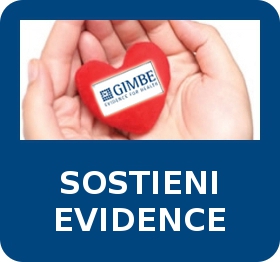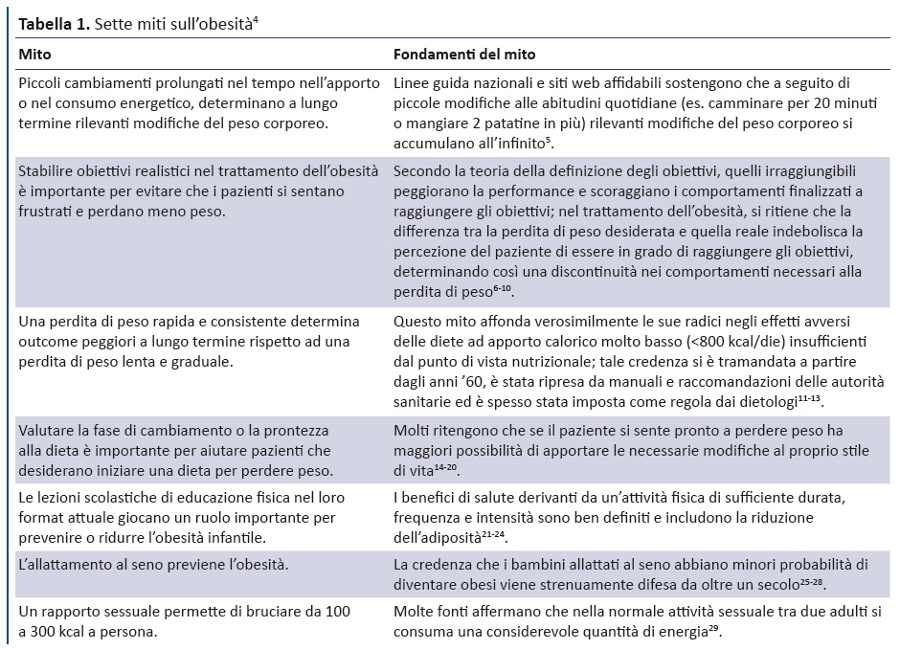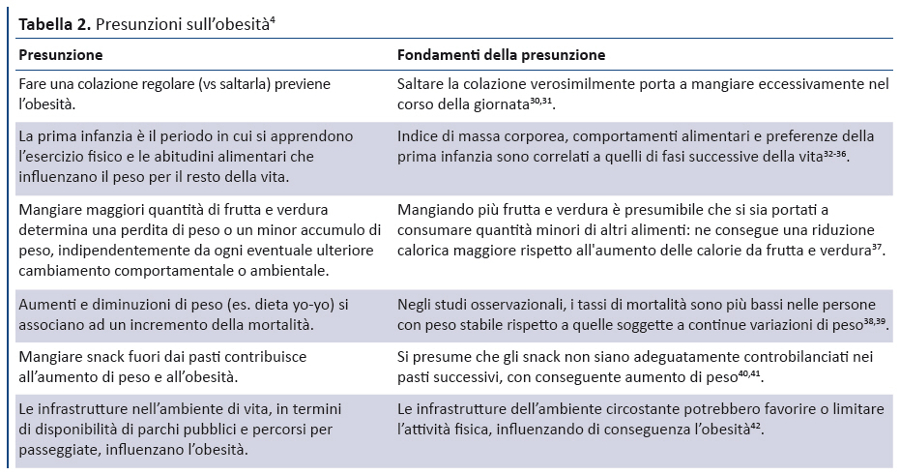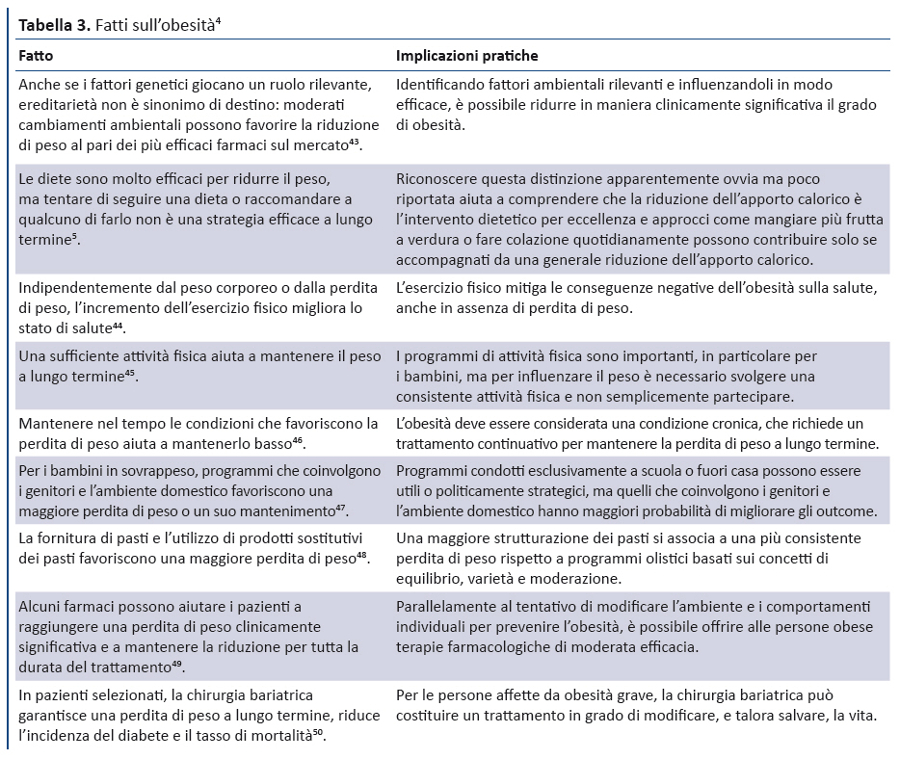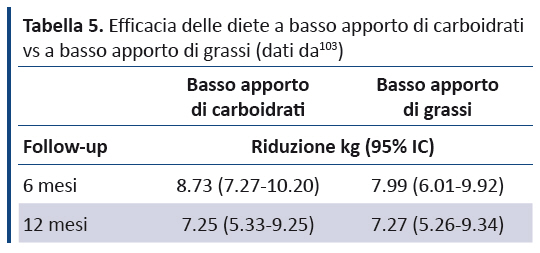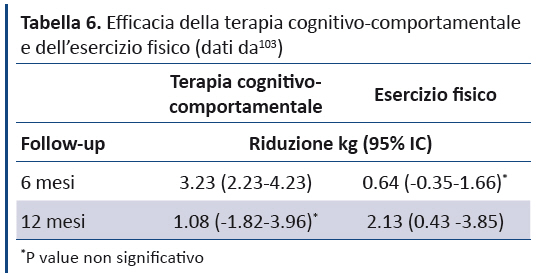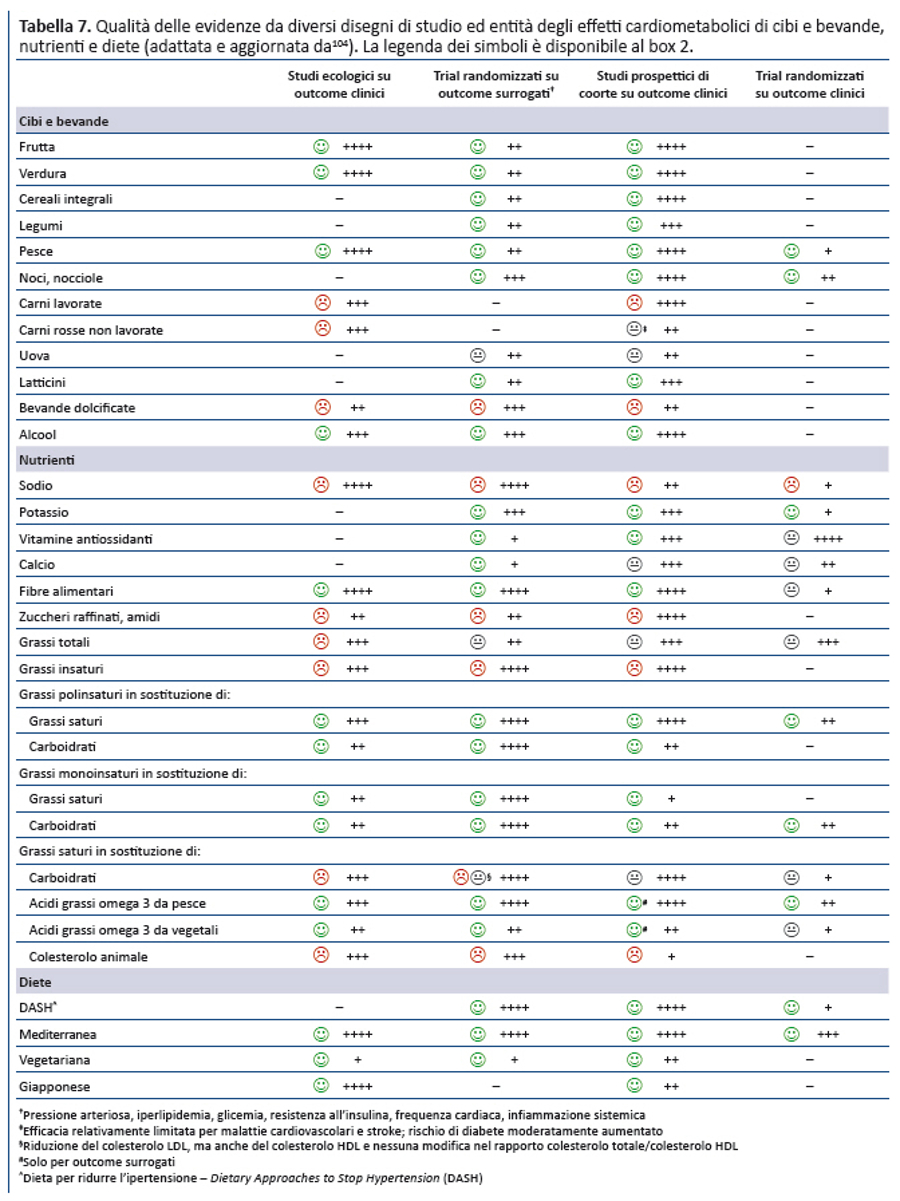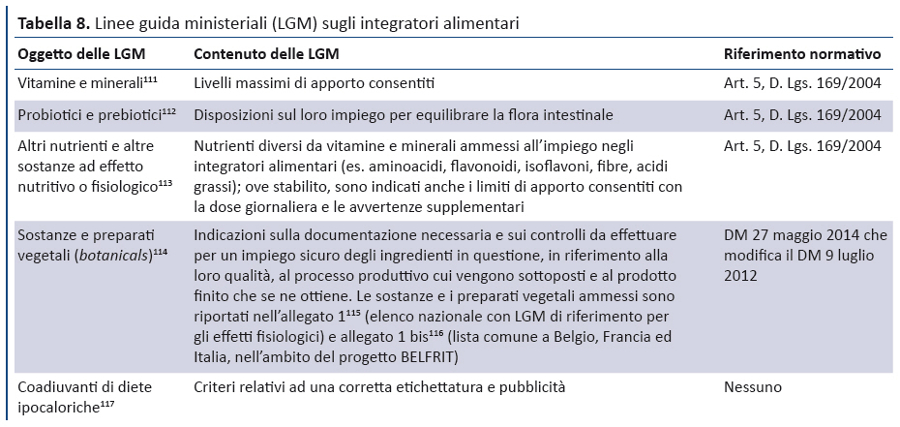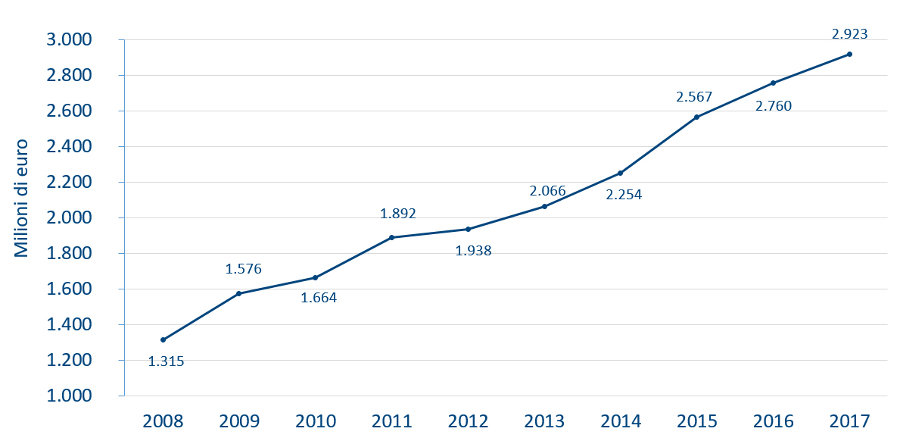Alimenti, diete e integratori: la scienza della nutrizione
tra miti, presunzioni ed evidenze
Position Statement GIMBE
Alimenti, diete e integratori: la scienza della nutrizione
tra miti, presunzioni ed evidenze
Fondazione GIMBEEvidence 2018;10(4): e1000180 doi: 10.4470/E1000180
Pubblicato: 16 aprile 2018
Copyright: © 2018 Fondazione GIMBE Questo è un articolo open-access, distribuito con licenza Creative Commons Attribution, che ne consente lâutilizzo, la distribuzione e la riproduzione su qualsiasi supporto esclusivamente per fini non commerciali, a condizione di riportare sempre autore e citazione originale.
1. Nestle M. Soda politics: taking on big soda (and winning). Oxford University Press, 2015.
2. Messina M, Lampe JW, Birt DF, et al. Reductionism and the narrowing nutrition perspective: time for reevaluation and emphasis on food synergy. J Am Diet Assoc 2001;101:1416-9.
3. Davis C, Saltos E. Dietary recommendations and how they have changed over time. Americaâs Eating habits: changes and consequences: Agriculture Information Bulletin No 750. ERA, 1999.
4. Casazza K, Fontaine KR, Astrup A, Birch LL, Brown AW, Bohan Brown MM, Durant N, Dutton G, Foster EM, Heymsfield SB, et al. Myths, presumptions, and facts about obesity. N Engl J Med 2013;368:446â54.
5. Heymsfield SB. Energy intake: reduced as prescribed? Am J Clin Nutr 2011;94:3-4.
6. Fabricatore AN, Wadden TA, Womble LG et al. The role of patientsâ expectations and goals in the behavioral and pharmacological treatment of obesity. Int J Obes (Lond) 2007;31:1739-1745.
7. Linde JA, Jeffery RW, Finch EA, Ng DM, Rothman AJ. Are unrealistic weight loss goals associated with outcomes for overweight women? Obes Res 2004;12:569-576.
8. Ames GE, Perri MG, Fox LD et al. Changing weight-loss expectations: a randomized pilot study. Eat Behav 2005;6:259-269.
9. Foster GD, Phelan S, Wadden TA, Gill D, Ermold J, Didie E. Promoting more modest weight losses: a pilot study. Obes Res 2004;12:1271-1277.
10. Jeffery RW, Finch EA, Ng DM, Rothman AJ. Are unrealistic weight loss goals associated with outcomes for overweight women? Obes Res 2004; 12: 569-76.
11. Bliddal H, Leeds AR, Stigsgaard L, Astrup A, Christensen R. Weight loss as treatment for knee osteoarthritis symptoms in obese patients: 1-year results from a randomised controlled trial. Ann Rheum Dis 2011;70:1798-1803.
12. Toubro S, Astrup A. Randomised comparison of diets for maintaining obese subjectsâ weight after major weight loss: ad lib, low fat, high carbohydrate diet v fixed energy intake. BMJ 1997;314:29-34.
13. Tsai AG, Wadden TA. The evolution of very-low-calorie diets: an update and metaanalysis. Obesity (Silver Spring) 2006;14:1283-1293.
14. Dixon JB, Laurie CP, Anderson ML, Hayden MJ, Dixon ME, OâBrien PE. Motivation, readiness to change, and weight loss following adjustable gastric band surgery. Obesity (Silver Spring) 2009;17:698-705.
15. Fontaine KR, Cheskin LJ, Allison DB. Predicting treatment attendance and weight loss: assessing the psychometric properties and predictive validity of the Dieting Readiness Test. J Pers Assess 1997;68:173-183.
16. Dinger MK, Heesch KC, Cipriani G, Qualls M. Comparison of two email-delivered, pedometer-based interventions to promote walking among insufficiently active women. J Sci Med Sport 2007;10:297-302.
17. Johnson SS, Paiva AL, Cummins CO et al. Transtheoretical model-based multiple behavior intervention for weight management: effectiveness on a population basis. Prev Med 2008;46:238-246.
18. Jones H, Edwards L, Vallis TM et al. Changes in diabetes self-care behaviors make a difference in glycemic control: the Diabetes Stages of Change (DiSC) study. Diabetes Care 2003;26:732-737.
19. Logue E, Sutton K, Jarjoura D, Smucker W, Baughman K, Capers C. Transtheoretical model chronic disease care for obesity in primary care: a randomized trial. Obes Res 2005;13(5):917-927.
20. Steptoe A, Kerry S, Rink E, Hilton S. The impact of behavioral counseling on stage of change in fat intake, physical activity, and cigarette smoking in adults at increased risk of coronary heart disease. Am J Public Health 2001;91:265-269.
21. Kain J, Uauy R, Albala, Vio F, Cerda R, Leyton B. School-based obesity prevention in Chilean primary school children: methodology and evaluation of a controlled study. International Journal of Obesity 2004;28:483-493.
22. Sollerhed AC, Ejlertsson G. Physical benefits of expanded physical education in primary school: findings from a 3-year intervention study in Sweden. The Journal of Sports Medicine and Physical Fitness 2008;18:102-107.
23. Harris KC, Kuramoto LK, Schulzer M, Retallack JE. Effect of school-based physical activity interventions on body mass index in children: a meta-analysis. CMAJ 2009;180:719-726.
24. Atlantis E, Barnes EH, Singh MA. Efficacy of exercise for treating overweight in children and adolescents: a systematic review. Int J Obes (Lond) 2006;30:1027-1040
25. Egger M, Smith GD, Sterne JA. Meta-analysis: is moving the goal post the answer? Lancet 1998;351(9114):1517.
26. Cope MB, Allison DB. Critical review of the World Health Organizationâs (WHO) 2007 report on âevidence of the long-term effects of breastfeeding: systematic reviews and meta-analysisâ with respect to obesity. Obes Rev 2008;9:594-605.
27. Cope MB, Allison DB. White hat bias: a threat to the integrity of scientific reporting. Acta Paediatr 2010;99:1615-1617.
28. Jiang M, Foster EM. Duration of Breastfeeding and Childhood Obesity: A Generalized Propensity Score Approach. Health Serv Res 2013;48(2 Pt 1):628-51
29. Bohlen JG, Held JP, Sanderson MO, Patterson RP. Heart rate, rate-pressure product, and oxygen uptake during four sexual activities. Arch Intern Med 1984;144:1745-8
30. Farshchi HR, Taylor MA, Macdonald IA. Deleterious effects of omitting breakfast on insulin sensitivity and fasting lipid profiles in healthy lean women. Am J Clin Nutr 2005;81:388-396.
31. Astbury NM, Taylor MA, Macdonald IA. Breakfast consumption affects appetite, energy intake, and the metabolic and endocrine responses to foods consumed later in the day in male habitual breakfast eaters. J Nutr 2011;141:1381-1389
32. Ogden LG, Stroebele N, Wyatt HR et al. Cluster analysis of the National Weight Control Registry to identify distinct subgroups maintaining successful weight loss. Obesity (Silver Spring) 2012.
33. Vickers MH, Breier BH, McCarthy D, Gluckman PD. Sedentary behavior during postnatal life is determined by the prenatal environment and exacerbated by postnatal hypercaloric nutrition. Am J Physiol Regul Integr Comp Physiol 2003;285:R271-R273.
34. Lucas A, Fewtrell MS, Cole TJ. Fetal origins of adult disease-the hypothesis revisited. BMJ 1999;319:245-249.
35. Aarnio M, Winter T, Peltonen J, Kujala UM, Kaprio J. Stability of leisure-time physical activity during adolescence--a longitudinal study among 16-, 17- and 18-year-old Finnish youth. Scand J Med Sci Sports 2002;12:179-185.
36. Oellingrath IM, Svendsen MV, Brantsaeter AL. Tracking of eating patterns and overweight â a follow-up study of Norwegian schoolchildren from middle childhood to early adolescence. Nutr J 2011;10:106.
37. Whybrow S, Harrison CL, Mayer C, James SR. Effects of added fruits and vegetables on dietary intakes and body weight in Scottish adults. Br J Nutr 2006;95:496-503.
38. List EO, Berryman DE, Wright-Piekarski J, Jara A, Funk K, Kopchick JJ. The effects of weight cycling on lifespan in male C57BL/6J mice. Int J Obes (Lond) 2013;37:1088-94
39. Stevens VL, Jacobs EJ, Sun J, Patel AV, McCullough ML, Teras LR, Gapstur SM.Weight cycling and mortality in a large prospective US study. Am J Epidemiol 2012;175:785-92.
40. Hendriksen MA, Boer JM, Du H, Feskens EJ, van der AD. No consistent association between consumption of energy-dense snack foods and annual weight and waist circumference changes in Dutch adults. Am J Clin Nutr 2011;94:19-25.
41. Northstone K, Smith AD, Newby PK, Emmett PM. Longitudinal comparisons of dietary patterns derived by cluster analysis in 7- to 13-year-old children. Br J Nutr 2013;109:2050-8.
42. Feng J, Glass TA, Curriero FC, Stewart WF, Schwartz BS. The built environment and obesity: a systematic review of the epidemiologic evidence. Health Place 2010;16:175-190.
43. Hewitt JK. The genetics of obesity: what have genetic studies told us about the environment. Behav Genet 1997;27:353-8.
44. Carroll S, Dudfield M. What is the relationship between exercise and metabolic abnormalities? A review of the metabolic syndrome. Sports Med 2004;34:371-418.
45. Wu T, Gao X, Chen M, van Dam RM. Long-term effectiveness of diet-plus-exercise interventions vs. diet-only interventions for weight loss: a meta-analysis. Obes Rev 2009;10:313-23.
46. Middleton KM, Patidar SM, Perri MG. The impact of extended care on the longterm maintenance of weight loss: a systematic review and meta-analysis. Obes Rev 2012;13:509-17.
47. McLean N, Griffin S, Toney K, Hardeman W. Family involvement in weight control, weight maintenance and weightloss interventions: a systematic review of randomised trials. Int J Obes Relat Metab Disord 2003;27:987-1005.
48. Wing RR, Jeffery RW. Food provision as a strategy to promote weight loss. Obes Res 2001;9:Suppl 4:271S-275S.
49. Wright SM, Aronne LJ. Obesity in 2010: the future of obesity medicine: where do we go from here? Nat Rev Endocrinol 2011;7:69-70.
50. Sjöström L, Lindroos A-K, Peltonen M, et al. Lifestyle, diabetes, and cardiovascular risk factors 10 years after bariatric surgery. N Engl J Med 2004;351:2683-93.
51. Young SS, Karr A. Deming, data, and observational studies: a process out of control and needing fixing. Significance 2011;8:116-20.
52. Taubes G. Epidemiology faces its limits. Science 1995;269:164-9.
53. Archer E, Hand GA, Blair SN. Validity of US nutritional surveillance: National Health and Nutrition Examination Survey caloric energy intake data, 1971-2010. PLoS One 2013;8:e76632.
54. Illner AK, Freisling H, Boeing H, Huybrechts I, Crispim SP, Slimani N. Review and evaluation of innovative technologies for measuring diet in nutritional epidemiology. Int J Epidemiol 2012;41:1187-203.
55. Schoenfeld JD, Ioannidis JP. Is everything we eat associated with cancer? A systematic cookbook review. Am J Clin Nutr 2013;97:127â34.
56. Siontis GC, Ioannidis JP. Risk factors and interventions with statistically significant tiny effects. Int J Epidemiol 2011;40:1292-307.
57. De Lorgeril M, Salen P, Martin JL, Monjaud I, Delaye J, Mamelle N. Mediterranean diet, traditional risk factors, and the rate of cardiovascular complications after myocardial infarction: final report of the Lyon Diet Heart Study. Circulation 1999;99:779-85.
58. Estruch R, Ros E, Salas-Salvadó J, Covas M-I, Corella D, Arós F, et al. Primary prevention of cardiovascular disease with a Mediterranean diet. N Engl J Med 2013;368:1279-90.
59. Montori VM, Devereaux PJ, Adhikari NK, Burns KE, Eggert CH, Briel M, et al. Randomized trials stopped early for benefit: a systematic review. JAMA 2005;294:2203-9.
60. Guasch-Ferré M, Bulló M, MartÃnez-González MÃ, Ros E, Corella D, Estruch R, et al. Frequency of nut consumption and mortality risk in the PREDIMED nutrition intervention trial. BMC Med 2013;11:164.
61. US Burden of Disease Collaborators. The state of US Health, 1990-2010. Burden of diseases, injuries, and risk factors. JAMA 2013;310:591-608
62. Ioannidis JP. Implausible results in human nutrition research. BMJ 2013;347:f6698.
63. Aveyard P, Yach D, Gilmore AB, Capewell S. Should we welcome food industry funding of public health research? BMJ 2016;353:i2161
64. Mozaffarian D. Conflict of interest and the role of the food industry in nutrition research. JAMA 2017;317:1755-6.
65. Bes-Rastrollo M, Schulze MB, Ruiz-Canela M, Martinez-Gonzalez MA. Financial conflicts of interest and reporting bias regarding the association between sugar-sweetened beverages and weight gain: a systematic review of systematic reviews. PLoS Med 2013;10:e1001578
66. Schillinger D, Tran J, Mangurian C, Kearns C. Do sugar-sweetened beverages cause obesity and diabetes? industry and the manufacture of scientific controversy. Ann Intern Med 2016;165:895-7.
67. Mandrioli D, Kearns CE, Bero LA. Relationship between research outcomes and risk of bias, study sponsorship, and author financial conflicts of interest in reviews of the effects of artificially sweetened beverages on weight outcomes: a systematic review of reviews. PLoS One 2016;11:e0162198.
68. Chartres N, Fabbri A, Bero LA. Association of industry sponsorship with outcomes of nutrition studies: a systematic review and meta-analysis. JAMA Intern Med 2016;176:1769-77
69. Lundh A, Lexchin J, Mintzes B, Schroll JB, Bero L. Industry sponsorship and research outcome. Cochrane Database Syst Rev 2017;2:MR000033.
70. Centers for Disease Control and Prevention. CDCâs guiding principles for public-private partnerships. 2014. Disponibile a: www.cdc.gov/partners/pdf/partnershipguidance-4-16-14.pdf. Ultimo accesso: 12 aprile 2018
71. UK Prevention Research Partnership. UKPRP principles for working with industry. 2017. Disponibile a: www.mrc.ac.uk/documents/pdf/ukprp-principles-for-working-with-industry. Ultimo accesso: 12 aprile 2018
72. Medical Research Council. MRC priorities for nutrition research. 2017. Disponibile a: https://mrc.ukri.org/documents/pdf/review-of-nutrition-and-human-health. Ultimo accesso: 12 aprile 2018
73. Cope MB, Allison DB. White hat bias: examples of its presence in obesity research and a call for renewed commitment to faithfulness in research reporting. Int J Obes (Lond) 2010;34:84â8.
74. Ioannidis JPA, Trepanowski JF. Disclosures in Nutrition Research: Why It Is Different. JAMA 2018;319:547-548.
75. Barnard ND, Willett WC, Ding EL. The Misuse of Meta-analysis in Nutrition Research. JAMA 2017;318:1435-1436.
76. Shamseer L, Moher D, Clarke M, Ghersi D, Liberati A, Petticrew M, Shekelle P, Stewart LA; PRISMA-P Group. Preferred reporting items for systematic review and meta-analysis protocols (PRISMA-P) 2015: elaboration and explanation. BMJ 2015;350:g7647.
77. Liberati A, Altman DG, Tetzlaff J, Mulrow C, Gøtzsche PC, Ioannidis JP, Clarke M, Devereaux PJ, Kleijnen J, Moher D. The PRISMA statement for reporting systematic reviews and meta-analyses of studies that evaluate healthcare interventions: explanation and elaboration. BMJ 2009;339:b2700.
78. Lucas M. Conflicts of interest in nutritional sciences: The forgotten bias in meta-analysis. World J Methodol 2015;5:175-8.
79. Brouwers MC, Kho ME, Browman GP, Burgers JS, Cluzeau F, Feder G, Fervers B, Graham ID, Grimshaw J, Hanna SE, Littlejohns P, Makarski J, Zitzelsberger L; AGREE Next Steps Consortium. AGREE II: advancing guideline development, reporting and evaluation in health care. CMAJ.2010;182:E839-42.
80. IOM (Institute of Medicine). 2011. Clinical Practice Guidelines We Can Trust. Washington, DC: The National Academies Press.
81. Qaseem A, Forland F, Macbeth F, Ollenschläger G, Phillips S, van der Wees P; Board of Trustees of the Guidelines International Network. Guidelines International Network: toward international standards for clinical practice guidelines. Ann Intern Med 2012;156:525-31.
82. Blake P, Durão S, Naude CE, Bero L. An analysis of methods used to synthesize evidence and grade recommendations in food-based dietary guidelines Nutr Rev 2018;76:290-300.
83. U.S. Department of Health and Human Services, U.S. Department of Agriculture. Dietary Guidelines for Americans 2015â2020. 8th Edition. December 2015. Disponibile a: www.health.gov/dietaryguidelines/2015/guidelines. Ultimo accesso: 12 aprile 2018
84. Mann J, Morenga LT, McLean R, Swinburn B, Mhurchu CN, Jackson R, Kennedy J, Beaglehole R.Dietary guidelines on trial: the charges are not evidence based. Lancet 2016;388:851-3.
85. Nissen SE. U.S. Dietary Guidelines: An Evidence-Free Zone. Ann Intern Med 2016;164:558-9.
86. Teicholz N. The scientific report guiding the US dietary guidelines: is it scientific? BMJ 2015;351:h4962. Erratum in: BMJ. 2015;351:h5686.
87. National Academies of Sciences, Engineering, and Medicine, Health and Medicine Division, Food and Nutrition Board, Committee to Review the Process to Update the Dietary Guidelines for Americans. Redesigning the Process for Establishing the Dietary Guidelines for Americans. Washington (DC): National Academies Press (US); 2017 Nov 16. Disponibile a: www.nap.edu/catalog/24883/redesigning-the-process-for-establishing-the-dietary-guidelines-for-americans. Ultimo accesso: 12 aprile 2018
88. National Academies of Sciences, Engineering, and Medicine, Health and Medicine Division, Food and Nutrition Board, Committee to Review the Process to Update the Dietary Guidelines for Americans. Optimizing the Process for Establishing the Dietary Guidelines for Americans: The Selection Process. Washington (DC): National Academies Press (US); 2017 Nov 16.. Disponibile a: www.nap.edu/catalog/24637/optimizing-the-process-for-establishing-the-dietary-guidelinesfor-americans. Ultimo accesso: 12 aprile 2018
89. Bero L. Developing reliable dietary guidelines. BMJ 2017;359:j4845.
90. Quaderni del Ministero della Salute. Nutrire il pianeta, nutrirlo in salute. Equilibri nutrizionali di una sana alimentazione. Ottobre 2015. Disponibile a: www.quadernidellasalute.it/portale/quaderni/dettaglioQuaderni.jsp?lingua=italiano&id=2556. Ultimo accesso: 12 aprile 2018
91. Gruppo di lavoro DM 1 settembre 2003. Elaborazione del tipo di dieta verso cui indirizzare il cittadino, consigliando le opportune variazioni. Relazione conclusiva del giugno 2004. Disponibile a: www.piramideitaliana.it/files_allegati/gruppodilavoro.pdf. Ultimo accesso: 12 aprile 2018
92. Ministero delle Politiche Agricole e Forestali, Istituto Nazionale di Ricerca per gli Alimenti e la Nutrizione (INRAN) Linee guida per una sana alimentazione italiana. Revisione 2003. Disponibile a: www.salute.gov.it/imgs/C_17_pubblicazioni_652_allegato.pdf. Ultimo accesso: 12 aprile 2018
93. CREA - Consiglio per la ricerca in agricoltura e lâanalisi dellâeconomia agraria. Dal Crea le prime anticipazioni delle nuove Linee Guida per una sana alimentazione. Disponibile a: www.crea.gov.it/dal-crea-le-prime-anticipazioni-delle-nuove-linee-guida-per-una-sana-alimentazione. Ultimo accesso: 12 aprile 2018
94. Società Italiana di Nutrizione Umana (SINU). LARN. Livelli di Assunzione di Riferimento di Nutrienti ed energia per la popolazione italiana. IV Revisione. Disponibile a: www.sinu.it/html/cnt/larn.asp. Ultimo accesso: 12 aprile 2018
95. Società Italiana di Nutrizione Umana (SINU). Tabelle LARN 2014. Disponibile a: www.sinu.it/html/pag/tabelle_larn_2014_rev.asp. Ultimo accesso: 12 aprile 2018
96. Istituto Superiore di Sanità . ISS Salute. Diete. 28 febbraio 2018. Disponibile a: www.issalute.it/index.php/la-salute-dalla-a-alla-z-menu/d/dieta. Ultimo accesso: 12 aprile 2018
97. Istituto Superiore di Sanità . ISS Salute. Diete e stili alimentari alternative. 28 febbraio 2018. Disponibile a: www.issalute.it/index.php/la-salute-dalla-a-alla-z-menu/d/diete-e-stili-alimentari-alternativi. Ultimo accesso: 12 aprile 2018
98. Marketdata Enterprises. The USWeight Loss & Diet Control Market. Lynbrook, NY: Marketdata Enterprises; 2009.
99. Pagoto SL, Appelhans BM. A call for an end to the diet debates. JAMA. 2013;310:687-688.
100. Porrini M, Santangelo A, Crovetti R, Riso P, Testolin G, Blundell JE.Weight, protein, fat, and timing of preloads affect food intake. Physiol Behav 1997;62:563-570.
101. Freedman MR, King J, Kennedy E. Popular diets: a scientific review. Obes Res 2001;9(suppl 1):1S-40S.
102. Jensen MD, Ryan DH, Apovian CM, et al. 2013 AHA/ACC/TOS guideline for the management of overweight and obesity in adults: a report of the American College of Cardiology/American Heart Association Task Force on Practice Guidelines and the Obesity Society. J AmColl Cardiol. 2014;63(25 pt B):2985-3023.
103. Johnston BC, Kanters S, Bandayrel K, Wu P, Naji F, Siemieniuk RA, Ball GD, Busse JW, Thorlund K, Guyatt G, Jansen JP, Mills EJ. Comparison of weight loss among named diet programs in overweight and obese adults: a meta-analysis. JAMA 2014;312:923-33.
104. Mozaffarian D, Appel LJ, Van Horn L. Components of a cardioprotective diet: new insights. Circulation 2011;123:2870-91
105. Mozaffarian D. Mediterranean diet for primary prevention of cardiovascular disease. N Engl J Med 2013;369:673-4.23944310
106. Mozaffarian D. Nutrition and cardiovascular and metabolic diseases. In: Mann DLZD, Libby P, Bonow RO, Braunwald E, eds. Braunwaldâs heart disease: a textbook of cardiovascular medicine. 10th ed. Elsevier, 2015:1001-14.
107. Mozaffarian D. Dietary and policy priorities for cardiovascular disease, diabetes, and obesity: a comprehensive review. Circulation 2016;133:187-225.
108. Micha R, Peñalvo JL, Cudhea F, Imamura F, Rehm CD, Mozaffarian D. Association between dietary factors and mortality from heart disease, stroke, and diabetes in the United States. JAMA 2017;317:912-24.
109. Ministero della Salute. Integratori alimentari. Disponibile a: www.salute.gov.it/portale/temi/p2_5.jsp?lingua=italiano&area=Alimenti%20particolari%20e%20integratori&menu=integratori. Ultimo accesso: 12 aprile 2018
110. Ministero della Salute. Integratori alimentari e Linee guida ministeriali (LGM). Disponibile a: www.salute.gov.it/portale/temi/p2_6.jsp?id=1267&area=Alimenti%20particolari%20e%20integratori&menu=integratori. Ultimo accesso: 12 aprile 2018
111. Ministero della Salute. Direzione Generale per lâIgiene e la Sicurezza degli Alimenti e la Nutrizione. Apporti giornalieri di vitamine e minerali ammessi negli integratori alimentari. Rev. maggio 2017. Disponibile a: www.salute.gov.it/imgs/C_17_pagineAree_1268_listaFile_itemName_5_file.pdf. Ultimo accesso: 12 aprile 2018
112. Ministero della Salute. Dipartimento Sanità Pubblica Veterinaria, Sicurezza Alimentare e Organi Collegiali per la Tutela della Salute - Direzione Generale Igiene e Sicurezza degli Alimenti e della Nutrizione. Linee guida su probiotici e prebiotici. Rev. maggio 2013. Disponibile a: www.salute.gov.it/imgs/C_17_pubblicazioni_1016_allegato.pdf. Ultimo accesso: 12 aprile 2018
113. Ministero della Salute. Altri nutrienti e altre sostanze ad effetto nutritivo o fisiologico. Rev. novembre 2017. Disponibile a: www.salute.gov.it/imgs/C_17_pagineAree_1268_listaFile_itemName_4_file.pdf. Ultimo accesso: 12 aprile 2018
114. Ministero della Salute. Direzione Generale per lâIgiene e la Sicurezza degli Alimenti e la Nutrizione. Linee guida sulla documentazione a supporto dellâimpiego di sostanze e preparati vegetali (botanicals) negli integratori alimentari di cui al DM 9 luglio 2012. Rev. gennaio 2015. Disponibile a: www.salute.gov.it/imgs/C_17_pagineAree_1424_listaFile_itemName_2_file.pdf. Ultimo accesso: 12 aprile 2018
115. Ministero della Salute. Allegato 1 al DM 9 luglio 2012 sulle âSostanze e preparati vegetali ammessiâ come aggiornato dal Decreto 27 marzo 2014 e âLinee guida ministeriali di riferimento per gli effetti fisiologiciâ aggiornate secondo il parere dell Commissione Unica per la Dietetica e la Nutrizione (CUDN) del 18 dicembre 2013. Disponibile a: www.trovanorme.salute.gov.it/norme/renderNormsanPdf?anno=0&codLeg=48636&parte=2&serie=. Ultimo accesso: 12 aprile 2018
116. Ministero della Salute. Allegato 1 bis (attuale lista BELFRIT). Disponibile a: www.trovanorme.salute.gov.it/norme/renderNormsanPdf?anno=0&codLeg=48636&parte=3&serie=. Ultimo accesso: 12 aprile 2018
117. Ministero della Salute. Dipartimento Sanità Pubblica Veterinaria, Sicurezza Alimentare e Organi Collegiali per la Tutela della Salute - Direzione Generale Igiene e Sicurezza degli Alimenti e della Nutrizione. Raccomandazioni sugli integratori alimentari proposti come coadiuvanti di diete per il controllo e la riduzione del peso. Rev. Maggio 2013. Disponibile a: www.salute.gov.it/imgs/C_17_pagineAree_1440_listaFile_itemName_0_file.pdf. Ultimo accesso: 12 aprile 2018
118. Ministero della Salute. Registro degli integratori alimentari. Parte A - Elenco in ordine alfabetico per prodotto. Disponibile a: www.salute.gov.it/imgs/C_17_pagineAree_3668_listaFile_itemName_0_file.pdf. Ultimo accesso: 12 aprile 2018
119. Ministero della Salute. Registro degli integratori alimentari. Parte B - Elenco in ordine alfabetico per impresa. Disponibile a: www.salute.gov.it/imgs/C_17_pagineAree_3668_listaFile_itemName_1_file.pdf. Ultimo accesso: 12 aprile 2018
120. Centro Studi FederSalus. Terza indagine di settore 2017. La filiera italiana degli integratori alimentari. Marzo 2018. Disponibile a: www.federsalus.it//drive/File/documenti_news/1520510527Indagine%20di%20settore%202017.pdf. Ultimo accesso: 12 aprile 2018
121. Elaborazione FederSalus su dati Euromonitor International Eastern and Western Europe, categoria Vitamins and Dietary Supplements Current Prices - Fixed 2016 Exchange Rates. In: Centro Studi FederSalus. Terza indagine di settore 2017. La filiera italiana degli integratori alimentari. Marzo 2018. Pag. 12. Disponibile a: www.federsalus.it//drive/File/documenti_news/1520510527Indagine%20di%20settore%202017.pdf. Ultimo accesso: 12 aprile 2018
122. Kantor ED, Rehm CD, DuM, White E, Giovannucci EL. Trends in dietary supplement use among US adults from 1999-2012. JAMA 2016;316:1464-1474.
123. Federazione Italiana Scienze della Vita (FISV). Gruppo di Lavoro âSalute e qualità della vitaâ. Due parole sugli integratori alimentari. Servono? Sono sicuri? 5 marzo 2018. Disponibile a: www.fisv.org/gdl-salute-e-qualit%C3%A0-della-vita/item/592-due-parole-sugli-integratori-alimentari-servono-sono-sicuri. Ultimo accesso: 12 aprile 2018
124. Cohen PA. The supplement paradox: negligible benefits, robust consumption. JAMA 2016;316:1453-1454.
125. Linee Guida sulla Comunicazione degli integratori alimentari. Gennaio 2018. Disponibile a: www.federsalus.it//drive/File/documenti_news/1518617906Linee%20Guida%20Comunicazione_2018%20.pdf. Ultimo accesso: 12 aprile 2018
126. Position Paper. Il ruolo dellâintegrazione alimentare in farmacia. Marzo 2018. Disponibile a: www.federsalus.it/drive/File/documenti_news/1522923950Il%20ruolo%20dell%20integrazione%20alimentare%20in%20farmacia.pdf. Ultimo accesso: 12 aprile 2018
127. Manson JE, Bassuk SS. Vitamin and mineral supplements: what clinicians need to know. JAMA 2018;319:859-860.
128. Marra MV, Boyar AP. Position of the American Dietetic Association: nutrient supplementation. J Am Diet Assoc 2009;109:2073-2085.
129. Istituto Superiore di Sanità . ISS Salute. Integratori alimentari. Febbraio 2018. Disponibile a: www.issalute.it/index.php/la-salute-dalla-a-alla-z-menu/i/integratori-alimentari. Ultimo accesso: 12 aprile 2018
130. Guallar E, Stranges S, Mulrow C, Appel LJ, Miller ER 3rd. Enough is enough: Stop wasting money on vitamin and mineral supplements. Ann Intern Med 2013;159:850-1.
131. Fortmann SP, Burda BU, Senger CA, Lin JS, Whitlock EP.Vitamin and mineral supplements in the primary prevention of cardiovascular disease and cancer: An updated systematic evidence review for the U.S. Preventive Services Task Force. Ann Intern Med 2013;159:824-34.
132. Moyer VA; U.S. Preventive Services Task Force.Vitamin, mineral, and multivitamin supplements for the primary prevention of cardiovascular disease and cancer: U.S. Preventive services Task Force recommendation statement. Ann Intern Med 2014;160:558-64.
133. COcoa Supplement and Multivitamin Outcomes Study (COSMOS). ClinicalTrials.gov Identifier: NCT02422745. Disponibile a: www.clinicaltrials.gov/ct2/show/NCT02422745. Ultimo accesso: 12 aprile 2018
134. Bjelakovic G, Nikolova D, Gluud C. Antioxidant supplements to prevent mortality. JAMA 2013;310:1178-9.
135. Miller ER 3rd, Pastor-Barriuso R, Dalal D, Riemersma RA, Appel LJ, Guallar E. Meta-analysis: high-dosage vitamin E supplementation may increase all cause mortality. Ann Intern Med 2005;142:37-46.
136. Rautiainen S, Manson JE, Lichtenstein AH, Sesso HD. Dietary supplements and disease prevention: a global overview. Nat Rev Endocrinol 2016;12:407-420.
137. Lin JS, OâConnor E, Rossom RC, Perdue LA, Eckstrom E. Screening for cognitive impairment in older adults: a systematic review for the U.S. Preventive Services Task Force. Ann Intern Med 2013;159:601-12
138. Grodstein F, OâBrien J, Kang JH, Dushkes R, Cook NR, Okereke O, et al. Long-term multivitamin supplementation and cognitive function in men. A randomized trial. Ann Intern Med 2013;159:806-14.
139. Viswanathan M, Treiman KA, Kish-Doto J, Middleton JC, Coker-Schwimmer EJ, Nicholson WK. Folic Acid Supplementation for the Prevention of Neural Tube Defects: An Updated Evidence Report and Systematic Review for the US Preventive Services Task Force. JAMA 2017;317:190-203.
140. US Preventive Services Task Force, Bibbins-Domingo K, Grossman DC, Curry SJ, Davidson KW, Epling JW Jr, GarcÃa FA, Kemper AR, Krist AH, Kurth AE, Landefeld CS, Mangione CM, Phillips WR, Phipps MG, Pignone MP, Silverstein M, Tseng CW. Folic Acid Supplementation for the Prevention of Neural Tube Defects: US Preventive Services Task Force Recommendation Statement. JAMA 2017;317:183-189.
141. Roth DE, Leung M, Mesfin E, Qamar H, Watterworth J, Papp E.Vitamin D supplementation during pregnancy: state of the evidence from a systematic review of randomised trials. BMJ 2017;359:j5237.
142. Siu AL; U.S. Preventive Services Task Force. Screening for Iron Deficiency Anemia and Iron Supplementation in Pregnant Women to Improve Maternal Health and Birth Outcomes: U.S. Preventive Services Task Force Recommendation Statement. Ann Intern Med 2015;163(7):529-36.
143. Vitamin supplementation in pregnancy. Drug Ther Bull 2016;54:81-4.
144. American College of Obstetricians and Gynecologists. Nutrition during pregnancy. April 2015. Disponibile a: www.acog.org/Patients/FAQs/Nutrition-During-Pregnancy. Ultimo accesso: 12 aprile 2018
145. Institute of Medicine. Dietary Reference Intakes for Calcium and Vitamin D.Washington, DC: National Academies Press; 2011.
146. Vitamin D and Omega-3 Trial (VITAL). ClinicalTrials.gov Identifier: NCT01169259. Disponibile a: www.clinicaltrials.gov/ct2/show/NCT01169259. Ultimo accesso: 12 aprile 2018
147. The D-Health Trial: A trial of vitamin D for prevention of mortality and cancer in older Australian adults. Trial ID: ACTRN12613000743763. Disponibile a: www.anzctr.org.au/Trial/Registration/TrialReview.aspx?ACTRN=ACTRN12613000743763. Ultimo accesso: 12 aprile 2018
148. Dietary Guidelines Advisory Committee. Scientific Report of the 2015 Dietary Guidelines Advisory Committee. US Department of Agriculture, Agriculutural Research Service; 2015. Disponibile a: www.health.gov/dietaryguidelines/2015-scientific-report. Ultimo accesso: 12 aprile 2018
149. Mozaffarian D, Ludwig DS. The 2015 US Dietary Guidelines: Lifting the ban on total dietary fat. JAMA 2015;313:2421-2.
150. Mozaffarian D, Forouhi NG. Dietary guidelines and health-is nutrition science up to the task? BMJ 2018;360:k822.
151. Willett WC. Nutritional epidemiology. 3rd ed. Oxford University Press, 2012
152. Frieden TR. Evidence for health decision makingâbeyond randomized, controlled trials. N Engl J Med 2017;377:465-75
153. Hodson L, Skeaff CM, Fielding BA. Fatty acid composition of adipose tissue and blood in humans and its use as a biomarker of dietary intake. Prog Lipid Res 2008;47:348-80.
154. Mensink RP, Zock PL, Kester AD, Katan MB. Effects of dietary fatty acids and carbohydrates on the ratio of serum total to HDL cholesterol and on serum lipids and apolipoproteins: a meta-analysis of 60 controlled trials. Am J Clin Nutr 2003;77:1146-55.
155. Mozaffarian D, Wu JH. Omega-3 fatty acids and cardiovascular disease: effects on risk factors, molecular pathways, and clinical events. J Am Coll Cardiol 2011;58:2047-67.
156. Imamura F, Micha R, Wu JH, et al. Effects of saturated fat, polyunsaturated fat, monounsaturated fat, and carbohydrate on glucose-insulin homeostasis: a systematic review and meta-analysis of randomised controlled feeding trials. PLoS Med 2016;13:e1002087.
157. Mozaffarian D, Micha R, Wallace S. Effects on coronary heart disease of increasing polyunsaturated fat in place of saturated fat: a systematic review and meta-analysis of randomized controlled trials. PLoS Med 2010;7:e1000252.
158. Del Gobbo LC, Imamura F, Aslibekyan S, et al. Cohorts for Heart and Aging Research in Genomic Epidemiology (CHARGE) Fatty Acids and Outcomes Research Consortium (FORCe). ?-3 Polyunsaturated Fatty Acid Biomarkers and Coronary Heart Disease: Pooling Project of 19 Cohort Studies. JAMA Intern Med 2016;176:1155-66.
159. Forouhi NG, Imamura F, Sharp SJ, et al. Association of plasma phospholipid n-3 and n-6 polyunsaturated fatty acids with type 2 diabetes: The EPIC-InterAct Case-Cohort Study. PLoS Med 2016;13:e1002094.
160. Gadbury GL, Allison DB. Inappropriate fiddling with statistical analyses to obtain a desirable p-value: tests to detect its presence in published literature. PLoS One 2012;7:e46363.
161. EQUATOR Network. Disponibile a. www.equator-network.org. Ultimo accesso: 12 aprile 2018
2. Messina M, Lampe JW, Birt DF, et al. Reductionism and the narrowing nutrition perspective: time for reevaluation and emphasis on food synergy. J Am Diet Assoc 2001;101:1416-9.
3. Davis C, Saltos E. Dietary recommendations and how they have changed over time. Americaâs Eating habits: changes and consequences: Agriculture Information Bulletin No 750. ERA, 1999.
4. Casazza K, Fontaine KR, Astrup A, Birch LL, Brown AW, Bohan Brown MM, Durant N, Dutton G, Foster EM, Heymsfield SB, et al. Myths, presumptions, and facts about obesity. N Engl J Med 2013;368:446â54.
5. Heymsfield SB. Energy intake: reduced as prescribed? Am J Clin Nutr 2011;94:3-4.
6. Fabricatore AN, Wadden TA, Womble LG et al. The role of patientsâ expectations and goals in the behavioral and pharmacological treatment of obesity. Int J Obes (Lond) 2007;31:1739-1745.
7. Linde JA, Jeffery RW, Finch EA, Ng DM, Rothman AJ. Are unrealistic weight loss goals associated with outcomes for overweight women? Obes Res 2004;12:569-576.
8. Ames GE, Perri MG, Fox LD et al. Changing weight-loss expectations: a randomized pilot study. Eat Behav 2005;6:259-269.
9. Foster GD, Phelan S, Wadden TA, Gill D, Ermold J, Didie E. Promoting more modest weight losses: a pilot study. Obes Res 2004;12:1271-1277.
10. Jeffery RW, Finch EA, Ng DM, Rothman AJ. Are unrealistic weight loss goals associated with outcomes for overweight women? Obes Res 2004; 12: 569-76.
11. Bliddal H, Leeds AR, Stigsgaard L, Astrup A, Christensen R. Weight loss as treatment for knee osteoarthritis symptoms in obese patients: 1-year results from a randomised controlled trial. Ann Rheum Dis 2011;70:1798-1803.
12. Toubro S, Astrup A. Randomised comparison of diets for maintaining obese subjectsâ weight after major weight loss: ad lib, low fat, high carbohydrate diet v fixed energy intake. BMJ 1997;314:29-34.
13. Tsai AG, Wadden TA. The evolution of very-low-calorie diets: an update and metaanalysis. Obesity (Silver Spring) 2006;14:1283-1293.
14. Dixon JB, Laurie CP, Anderson ML, Hayden MJ, Dixon ME, OâBrien PE. Motivation, readiness to change, and weight loss following adjustable gastric band surgery. Obesity (Silver Spring) 2009;17:698-705.
15. Fontaine KR, Cheskin LJ, Allison DB. Predicting treatment attendance and weight loss: assessing the psychometric properties and predictive validity of the Dieting Readiness Test. J Pers Assess 1997;68:173-183.
16. Dinger MK, Heesch KC, Cipriani G, Qualls M. Comparison of two email-delivered, pedometer-based interventions to promote walking among insufficiently active women. J Sci Med Sport 2007;10:297-302.
17. Johnson SS, Paiva AL, Cummins CO et al. Transtheoretical model-based multiple behavior intervention for weight management: effectiveness on a population basis. Prev Med 2008;46:238-246.
18. Jones H, Edwards L, Vallis TM et al. Changes in diabetes self-care behaviors make a difference in glycemic control: the Diabetes Stages of Change (DiSC) study. Diabetes Care 2003;26:732-737.
19. Logue E, Sutton K, Jarjoura D, Smucker W, Baughman K, Capers C. Transtheoretical model chronic disease care for obesity in primary care: a randomized trial. Obes Res 2005;13(5):917-927.
20. Steptoe A, Kerry S, Rink E, Hilton S. The impact of behavioral counseling on stage of change in fat intake, physical activity, and cigarette smoking in adults at increased risk of coronary heart disease. Am J Public Health 2001;91:265-269.
21. Kain J, Uauy R, Albala, Vio F, Cerda R, Leyton B. School-based obesity prevention in Chilean primary school children: methodology and evaluation of a controlled study. International Journal of Obesity 2004;28:483-493.
22. Sollerhed AC, Ejlertsson G. Physical benefits of expanded physical education in primary school: findings from a 3-year intervention study in Sweden. The Journal of Sports Medicine and Physical Fitness 2008;18:102-107.
23. Harris KC, Kuramoto LK, Schulzer M, Retallack JE. Effect of school-based physical activity interventions on body mass index in children: a meta-analysis. CMAJ 2009;180:719-726.
24. Atlantis E, Barnes EH, Singh MA. Efficacy of exercise for treating overweight in children and adolescents: a systematic review. Int J Obes (Lond) 2006;30:1027-1040
25. Egger M, Smith GD, Sterne JA. Meta-analysis: is moving the goal post the answer? Lancet 1998;351(9114):1517.
26. Cope MB, Allison DB. Critical review of the World Health Organizationâs (WHO) 2007 report on âevidence of the long-term effects of breastfeeding: systematic reviews and meta-analysisâ with respect to obesity. Obes Rev 2008;9:594-605.
27. Cope MB, Allison DB. White hat bias: a threat to the integrity of scientific reporting. Acta Paediatr 2010;99:1615-1617.
28. Jiang M, Foster EM. Duration of Breastfeeding and Childhood Obesity: A Generalized Propensity Score Approach. Health Serv Res 2013;48(2 Pt 1):628-51
29. Bohlen JG, Held JP, Sanderson MO, Patterson RP. Heart rate, rate-pressure product, and oxygen uptake during four sexual activities. Arch Intern Med 1984;144:1745-8
30. Farshchi HR, Taylor MA, Macdonald IA. Deleterious effects of omitting breakfast on insulin sensitivity and fasting lipid profiles in healthy lean women. Am J Clin Nutr 2005;81:388-396.
31. Astbury NM, Taylor MA, Macdonald IA. Breakfast consumption affects appetite, energy intake, and the metabolic and endocrine responses to foods consumed later in the day in male habitual breakfast eaters. J Nutr 2011;141:1381-1389
32. Ogden LG, Stroebele N, Wyatt HR et al. Cluster analysis of the National Weight Control Registry to identify distinct subgroups maintaining successful weight loss. Obesity (Silver Spring) 2012.
33. Vickers MH, Breier BH, McCarthy D, Gluckman PD. Sedentary behavior during postnatal life is determined by the prenatal environment and exacerbated by postnatal hypercaloric nutrition. Am J Physiol Regul Integr Comp Physiol 2003;285:R271-R273.
34. Lucas A, Fewtrell MS, Cole TJ. Fetal origins of adult disease-the hypothesis revisited. BMJ 1999;319:245-249.
35. Aarnio M, Winter T, Peltonen J, Kujala UM, Kaprio J. Stability of leisure-time physical activity during adolescence--a longitudinal study among 16-, 17- and 18-year-old Finnish youth. Scand J Med Sci Sports 2002;12:179-185.
36. Oellingrath IM, Svendsen MV, Brantsaeter AL. Tracking of eating patterns and overweight â a follow-up study of Norwegian schoolchildren from middle childhood to early adolescence. Nutr J 2011;10:106.
37. Whybrow S, Harrison CL, Mayer C, James SR. Effects of added fruits and vegetables on dietary intakes and body weight in Scottish adults. Br J Nutr 2006;95:496-503.
38. List EO, Berryman DE, Wright-Piekarski J, Jara A, Funk K, Kopchick JJ. The effects of weight cycling on lifespan in male C57BL/6J mice. Int J Obes (Lond) 2013;37:1088-94
39. Stevens VL, Jacobs EJ, Sun J, Patel AV, McCullough ML, Teras LR, Gapstur SM.Weight cycling and mortality in a large prospective US study. Am J Epidemiol 2012;175:785-92.
40. Hendriksen MA, Boer JM, Du H, Feskens EJ, van der AD. No consistent association between consumption of energy-dense snack foods and annual weight and waist circumference changes in Dutch adults. Am J Clin Nutr 2011;94:19-25.
41. Northstone K, Smith AD, Newby PK, Emmett PM. Longitudinal comparisons of dietary patterns derived by cluster analysis in 7- to 13-year-old children. Br J Nutr 2013;109:2050-8.
42. Feng J, Glass TA, Curriero FC, Stewart WF, Schwartz BS. The built environment and obesity: a systematic review of the epidemiologic evidence. Health Place 2010;16:175-190.
43. Hewitt JK. The genetics of obesity: what have genetic studies told us about the environment. Behav Genet 1997;27:353-8.
44. Carroll S, Dudfield M. What is the relationship between exercise and metabolic abnormalities? A review of the metabolic syndrome. Sports Med 2004;34:371-418.
45. Wu T, Gao X, Chen M, van Dam RM. Long-term effectiveness of diet-plus-exercise interventions vs. diet-only interventions for weight loss: a meta-analysis. Obes Rev 2009;10:313-23.
46. Middleton KM, Patidar SM, Perri MG. The impact of extended care on the longterm maintenance of weight loss: a systematic review and meta-analysis. Obes Rev 2012;13:509-17.
47. McLean N, Griffin S, Toney K, Hardeman W. Family involvement in weight control, weight maintenance and weightloss interventions: a systematic review of randomised trials. Int J Obes Relat Metab Disord 2003;27:987-1005.
48. Wing RR, Jeffery RW. Food provision as a strategy to promote weight loss. Obes Res 2001;9:Suppl 4:271S-275S.
49. Wright SM, Aronne LJ. Obesity in 2010: the future of obesity medicine: where do we go from here? Nat Rev Endocrinol 2011;7:69-70.
50. Sjöström L, Lindroos A-K, Peltonen M, et al. Lifestyle, diabetes, and cardiovascular risk factors 10 years after bariatric surgery. N Engl J Med 2004;351:2683-93.
51. Young SS, Karr A. Deming, data, and observational studies: a process out of control and needing fixing. Significance 2011;8:116-20.
52. Taubes G. Epidemiology faces its limits. Science 1995;269:164-9.
53. Archer E, Hand GA, Blair SN. Validity of US nutritional surveillance: National Health and Nutrition Examination Survey caloric energy intake data, 1971-2010. PLoS One 2013;8:e76632.
54. Illner AK, Freisling H, Boeing H, Huybrechts I, Crispim SP, Slimani N. Review and evaluation of innovative technologies for measuring diet in nutritional epidemiology. Int J Epidemiol 2012;41:1187-203.
55. Schoenfeld JD, Ioannidis JP. Is everything we eat associated with cancer? A systematic cookbook review. Am J Clin Nutr 2013;97:127â34.
56. Siontis GC, Ioannidis JP. Risk factors and interventions with statistically significant tiny effects. Int J Epidemiol 2011;40:1292-307.
57. De Lorgeril M, Salen P, Martin JL, Monjaud I, Delaye J, Mamelle N. Mediterranean diet, traditional risk factors, and the rate of cardiovascular complications after myocardial infarction: final report of the Lyon Diet Heart Study. Circulation 1999;99:779-85.
58. Estruch R, Ros E, Salas-Salvadó J, Covas M-I, Corella D, Arós F, et al. Primary prevention of cardiovascular disease with a Mediterranean diet. N Engl J Med 2013;368:1279-90.
59. Montori VM, Devereaux PJ, Adhikari NK, Burns KE, Eggert CH, Briel M, et al. Randomized trials stopped early for benefit: a systematic review. JAMA 2005;294:2203-9.
60. Guasch-Ferré M, Bulló M, MartÃnez-González MÃ, Ros E, Corella D, Estruch R, et al. Frequency of nut consumption and mortality risk in the PREDIMED nutrition intervention trial. BMC Med 2013;11:164.
61. US Burden of Disease Collaborators. The state of US Health, 1990-2010. Burden of diseases, injuries, and risk factors. JAMA 2013;310:591-608
62. Ioannidis JP. Implausible results in human nutrition research. BMJ 2013;347:f6698.
63. Aveyard P, Yach D, Gilmore AB, Capewell S. Should we welcome food industry funding of public health research? BMJ 2016;353:i2161
64. Mozaffarian D. Conflict of interest and the role of the food industry in nutrition research. JAMA 2017;317:1755-6.
65. Bes-Rastrollo M, Schulze MB, Ruiz-Canela M, Martinez-Gonzalez MA. Financial conflicts of interest and reporting bias regarding the association between sugar-sweetened beverages and weight gain: a systematic review of systematic reviews. PLoS Med 2013;10:e1001578
66. Schillinger D, Tran J, Mangurian C, Kearns C. Do sugar-sweetened beverages cause obesity and diabetes? industry and the manufacture of scientific controversy. Ann Intern Med 2016;165:895-7.
67. Mandrioli D, Kearns CE, Bero LA. Relationship between research outcomes and risk of bias, study sponsorship, and author financial conflicts of interest in reviews of the effects of artificially sweetened beverages on weight outcomes: a systematic review of reviews. PLoS One 2016;11:e0162198.
68. Chartres N, Fabbri A, Bero LA. Association of industry sponsorship with outcomes of nutrition studies: a systematic review and meta-analysis. JAMA Intern Med 2016;176:1769-77
69. Lundh A, Lexchin J, Mintzes B, Schroll JB, Bero L. Industry sponsorship and research outcome. Cochrane Database Syst Rev 2017;2:MR000033.
70. Centers for Disease Control and Prevention. CDCâs guiding principles for public-private partnerships. 2014. Disponibile a: www.cdc.gov/partners/pdf/partnershipguidance-4-16-14.pdf. Ultimo accesso: 12 aprile 2018
71. UK Prevention Research Partnership. UKPRP principles for working with industry. 2017. Disponibile a: www.mrc.ac.uk/documents/pdf/ukprp-principles-for-working-with-industry. Ultimo accesso: 12 aprile 2018
72. Medical Research Council. MRC priorities for nutrition research. 2017. Disponibile a: https://mrc.ukri.org/documents/pdf/review-of-nutrition-and-human-health. Ultimo accesso: 12 aprile 2018
73. Cope MB, Allison DB. White hat bias: examples of its presence in obesity research and a call for renewed commitment to faithfulness in research reporting. Int J Obes (Lond) 2010;34:84â8.
74. Ioannidis JPA, Trepanowski JF. Disclosures in Nutrition Research: Why It Is Different. JAMA 2018;319:547-548.
75. Barnard ND, Willett WC, Ding EL. The Misuse of Meta-analysis in Nutrition Research. JAMA 2017;318:1435-1436.
76. Shamseer L, Moher D, Clarke M, Ghersi D, Liberati A, Petticrew M, Shekelle P, Stewart LA; PRISMA-P Group. Preferred reporting items for systematic review and meta-analysis protocols (PRISMA-P) 2015: elaboration and explanation. BMJ 2015;350:g7647.
77. Liberati A, Altman DG, Tetzlaff J, Mulrow C, Gøtzsche PC, Ioannidis JP, Clarke M, Devereaux PJ, Kleijnen J, Moher D. The PRISMA statement for reporting systematic reviews and meta-analyses of studies that evaluate healthcare interventions: explanation and elaboration. BMJ 2009;339:b2700.
78. Lucas M. Conflicts of interest in nutritional sciences: The forgotten bias in meta-analysis. World J Methodol 2015;5:175-8.
79. Brouwers MC, Kho ME, Browman GP, Burgers JS, Cluzeau F, Feder G, Fervers B, Graham ID, Grimshaw J, Hanna SE, Littlejohns P, Makarski J, Zitzelsberger L; AGREE Next Steps Consortium. AGREE II: advancing guideline development, reporting and evaluation in health care. CMAJ.2010;182:E839-42.
80. IOM (Institute of Medicine). 2011. Clinical Practice Guidelines We Can Trust. Washington, DC: The National Academies Press.
81. Qaseem A, Forland F, Macbeth F, Ollenschläger G, Phillips S, van der Wees P; Board of Trustees of the Guidelines International Network. Guidelines International Network: toward international standards for clinical practice guidelines. Ann Intern Med 2012;156:525-31.
82. Blake P, Durão S, Naude CE, Bero L. An analysis of methods used to synthesize evidence and grade recommendations in food-based dietary guidelines Nutr Rev 2018;76:290-300.
83. U.S. Department of Health and Human Services, U.S. Department of Agriculture. Dietary Guidelines for Americans 2015â2020. 8th Edition. December 2015. Disponibile a: www.health.gov/dietaryguidelines/2015/guidelines. Ultimo accesso: 12 aprile 2018
84. Mann J, Morenga LT, McLean R, Swinburn B, Mhurchu CN, Jackson R, Kennedy J, Beaglehole R.Dietary guidelines on trial: the charges are not evidence based. Lancet 2016;388:851-3.
85. Nissen SE. U.S. Dietary Guidelines: An Evidence-Free Zone. Ann Intern Med 2016;164:558-9.
86. Teicholz N. The scientific report guiding the US dietary guidelines: is it scientific? BMJ 2015;351:h4962. Erratum in: BMJ. 2015;351:h5686.
87. National Academies of Sciences, Engineering, and Medicine, Health and Medicine Division, Food and Nutrition Board, Committee to Review the Process to Update the Dietary Guidelines for Americans. Redesigning the Process for Establishing the Dietary Guidelines for Americans. Washington (DC): National Academies Press (US); 2017 Nov 16. Disponibile a: www.nap.edu/catalog/24883/redesigning-the-process-for-establishing-the-dietary-guidelines-for-americans. Ultimo accesso: 12 aprile 2018
88. National Academies of Sciences, Engineering, and Medicine, Health and Medicine Division, Food and Nutrition Board, Committee to Review the Process to Update the Dietary Guidelines for Americans. Optimizing the Process for Establishing the Dietary Guidelines for Americans: The Selection Process. Washington (DC): National Academies Press (US); 2017 Nov 16.. Disponibile a: www.nap.edu/catalog/24637/optimizing-the-process-for-establishing-the-dietary-guidelinesfor-americans. Ultimo accesso: 12 aprile 2018
89. Bero L. Developing reliable dietary guidelines. BMJ 2017;359:j4845.
90. Quaderni del Ministero della Salute. Nutrire il pianeta, nutrirlo in salute. Equilibri nutrizionali di una sana alimentazione. Ottobre 2015. Disponibile a: www.quadernidellasalute.it/portale/quaderni/dettaglioQuaderni.jsp?lingua=italiano&id=2556. Ultimo accesso: 12 aprile 2018
91. Gruppo di lavoro DM 1 settembre 2003. Elaborazione del tipo di dieta verso cui indirizzare il cittadino, consigliando le opportune variazioni. Relazione conclusiva del giugno 2004. Disponibile a: www.piramideitaliana.it/files_allegati/gruppodilavoro.pdf. Ultimo accesso: 12 aprile 2018
92. Ministero delle Politiche Agricole e Forestali, Istituto Nazionale di Ricerca per gli Alimenti e la Nutrizione (INRAN) Linee guida per una sana alimentazione italiana. Revisione 2003. Disponibile a: www.salute.gov.it/imgs/C_17_pubblicazioni_652_allegato.pdf. Ultimo accesso: 12 aprile 2018
93. CREA - Consiglio per la ricerca in agricoltura e lâanalisi dellâeconomia agraria. Dal Crea le prime anticipazioni delle nuove Linee Guida per una sana alimentazione. Disponibile a: www.crea.gov.it/dal-crea-le-prime-anticipazioni-delle-nuove-linee-guida-per-una-sana-alimentazione. Ultimo accesso: 12 aprile 2018
94. Società Italiana di Nutrizione Umana (SINU). LARN. Livelli di Assunzione di Riferimento di Nutrienti ed energia per la popolazione italiana. IV Revisione. Disponibile a: www.sinu.it/html/cnt/larn.asp. Ultimo accesso: 12 aprile 2018
95. Società Italiana di Nutrizione Umana (SINU). Tabelle LARN 2014. Disponibile a: www.sinu.it/html/pag/tabelle_larn_2014_rev.asp. Ultimo accesso: 12 aprile 2018
96. Istituto Superiore di Sanità . ISS Salute. Diete. 28 febbraio 2018. Disponibile a: www.issalute.it/index.php/la-salute-dalla-a-alla-z-menu/d/dieta. Ultimo accesso: 12 aprile 2018
97. Istituto Superiore di Sanità . ISS Salute. Diete e stili alimentari alternative. 28 febbraio 2018. Disponibile a: www.issalute.it/index.php/la-salute-dalla-a-alla-z-menu/d/diete-e-stili-alimentari-alternativi. Ultimo accesso: 12 aprile 2018
98. Marketdata Enterprises. The USWeight Loss & Diet Control Market. Lynbrook, NY: Marketdata Enterprises; 2009.
99. Pagoto SL, Appelhans BM. A call for an end to the diet debates. JAMA. 2013;310:687-688.
100. Porrini M, Santangelo A, Crovetti R, Riso P, Testolin G, Blundell JE.Weight, protein, fat, and timing of preloads affect food intake. Physiol Behav 1997;62:563-570.
101. Freedman MR, King J, Kennedy E. Popular diets: a scientific review. Obes Res 2001;9(suppl 1):1S-40S.
102. Jensen MD, Ryan DH, Apovian CM, et al. 2013 AHA/ACC/TOS guideline for the management of overweight and obesity in adults: a report of the American College of Cardiology/American Heart Association Task Force on Practice Guidelines and the Obesity Society. J AmColl Cardiol. 2014;63(25 pt B):2985-3023.
103. Johnston BC, Kanters S, Bandayrel K, Wu P, Naji F, Siemieniuk RA, Ball GD, Busse JW, Thorlund K, Guyatt G, Jansen JP, Mills EJ. Comparison of weight loss among named diet programs in overweight and obese adults: a meta-analysis. JAMA 2014;312:923-33.
104. Mozaffarian D, Appel LJ, Van Horn L. Components of a cardioprotective diet: new insights. Circulation 2011;123:2870-91
105. Mozaffarian D. Mediterranean diet for primary prevention of cardiovascular disease. N Engl J Med 2013;369:673-4.23944310
106. Mozaffarian D. Nutrition and cardiovascular and metabolic diseases. In: Mann DLZD, Libby P, Bonow RO, Braunwald E, eds. Braunwaldâs heart disease: a textbook of cardiovascular medicine. 10th ed. Elsevier, 2015:1001-14.
107. Mozaffarian D. Dietary and policy priorities for cardiovascular disease, diabetes, and obesity: a comprehensive review. Circulation 2016;133:187-225.
108. Micha R, Peñalvo JL, Cudhea F, Imamura F, Rehm CD, Mozaffarian D. Association between dietary factors and mortality from heart disease, stroke, and diabetes in the United States. JAMA 2017;317:912-24.
109. Ministero della Salute. Integratori alimentari. Disponibile a: www.salute.gov.it/portale/temi/p2_5.jsp?lingua=italiano&area=Alimenti%20particolari%20e%20integratori&menu=integratori. Ultimo accesso: 12 aprile 2018
110. Ministero della Salute. Integratori alimentari e Linee guida ministeriali (LGM). Disponibile a: www.salute.gov.it/portale/temi/p2_6.jsp?id=1267&area=Alimenti%20particolari%20e%20integratori&menu=integratori. Ultimo accesso: 12 aprile 2018
111. Ministero della Salute. Direzione Generale per lâIgiene e la Sicurezza degli Alimenti e la Nutrizione. Apporti giornalieri di vitamine e minerali ammessi negli integratori alimentari. Rev. maggio 2017. Disponibile a: www.salute.gov.it/imgs/C_17_pagineAree_1268_listaFile_itemName_5_file.pdf. Ultimo accesso: 12 aprile 2018
112. Ministero della Salute. Dipartimento Sanità Pubblica Veterinaria, Sicurezza Alimentare e Organi Collegiali per la Tutela della Salute - Direzione Generale Igiene e Sicurezza degli Alimenti e della Nutrizione. Linee guida su probiotici e prebiotici. Rev. maggio 2013. Disponibile a: www.salute.gov.it/imgs/C_17_pubblicazioni_1016_allegato.pdf. Ultimo accesso: 12 aprile 2018
113. Ministero della Salute. Altri nutrienti e altre sostanze ad effetto nutritivo o fisiologico. Rev. novembre 2017. Disponibile a: www.salute.gov.it/imgs/C_17_pagineAree_1268_listaFile_itemName_4_file.pdf. Ultimo accesso: 12 aprile 2018
114. Ministero della Salute. Direzione Generale per lâIgiene e la Sicurezza degli Alimenti e la Nutrizione. Linee guida sulla documentazione a supporto dellâimpiego di sostanze e preparati vegetali (botanicals) negli integratori alimentari di cui al DM 9 luglio 2012. Rev. gennaio 2015. Disponibile a: www.salute.gov.it/imgs/C_17_pagineAree_1424_listaFile_itemName_2_file.pdf. Ultimo accesso: 12 aprile 2018
115. Ministero della Salute. Allegato 1 al DM 9 luglio 2012 sulle âSostanze e preparati vegetali ammessiâ come aggiornato dal Decreto 27 marzo 2014 e âLinee guida ministeriali di riferimento per gli effetti fisiologiciâ aggiornate secondo il parere dell Commissione Unica per la Dietetica e la Nutrizione (CUDN) del 18 dicembre 2013. Disponibile a: www.trovanorme.salute.gov.it/norme/renderNormsanPdf?anno=0&codLeg=48636&parte=2&serie=. Ultimo accesso: 12 aprile 2018
116. Ministero della Salute. Allegato 1 bis (attuale lista BELFRIT). Disponibile a: www.trovanorme.salute.gov.it/norme/renderNormsanPdf?anno=0&codLeg=48636&parte=3&serie=. Ultimo accesso: 12 aprile 2018
117. Ministero della Salute. Dipartimento Sanità Pubblica Veterinaria, Sicurezza Alimentare e Organi Collegiali per la Tutela della Salute - Direzione Generale Igiene e Sicurezza degli Alimenti e della Nutrizione. Raccomandazioni sugli integratori alimentari proposti come coadiuvanti di diete per il controllo e la riduzione del peso. Rev. Maggio 2013. Disponibile a: www.salute.gov.it/imgs/C_17_pagineAree_1440_listaFile_itemName_0_file.pdf. Ultimo accesso: 12 aprile 2018
118. Ministero della Salute. Registro degli integratori alimentari. Parte A - Elenco in ordine alfabetico per prodotto. Disponibile a: www.salute.gov.it/imgs/C_17_pagineAree_3668_listaFile_itemName_0_file.pdf. Ultimo accesso: 12 aprile 2018
119. Ministero della Salute. Registro degli integratori alimentari. Parte B - Elenco in ordine alfabetico per impresa. Disponibile a: www.salute.gov.it/imgs/C_17_pagineAree_3668_listaFile_itemName_1_file.pdf. Ultimo accesso: 12 aprile 2018
120. Centro Studi FederSalus. Terza indagine di settore 2017. La filiera italiana degli integratori alimentari. Marzo 2018. Disponibile a: www.federsalus.it//drive/File/documenti_news/1520510527Indagine%20di%20settore%202017.pdf. Ultimo accesso: 12 aprile 2018
121. Elaborazione FederSalus su dati Euromonitor International Eastern and Western Europe, categoria Vitamins and Dietary Supplements Current Prices - Fixed 2016 Exchange Rates. In: Centro Studi FederSalus. Terza indagine di settore 2017. La filiera italiana degli integratori alimentari. Marzo 2018. Pag. 12. Disponibile a: www.federsalus.it//drive/File/documenti_news/1520510527Indagine%20di%20settore%202017.pdf. Ultimo accesso: 12 aprile 2018
122. Kantor ED, Rehm CD, DuM, White E, Giovannucci EL. Trends in dietary supplement use among US adults from 1999-2012. JAMA 2016;316:1464-1474.
123. Federazione Italiana Scienze della Vita (FISV). Gruppo di Lavoro âSalute e qualità della vitaâ. Due parole sugli integratori alimentari. Servono? Sono sicuri? 5 marzo 2018. Disponibile a: www.fisv.org/gdl-salute-e-qualit%C3%A0-della-vita/item/592-due-parole-sugli-integratori-alimentari-servono-sono-sicuri. Ultimo accesso: 12 aprile 2018
124. Cohen PA. The supplement paradox: negligible benefits, robust consumption. JAMA 2016;316:1453-1454.
125. Linee Guida sulla Comunicazione degli integratori alimentari. Gennaio 2018. Disponibile a: www.federsalus.it//drive/File/documenti_news/1518617906Linee%20Guida%20Comunicazione_2018%20.pdf. Ultimo accesso: 12 aprile 2018
126. Position Paper. Il ruolo dellâintegrazione alimentare in farmacia. Marzo 2018. Disponibile a: www.federsalus.it/drive/File/documenti_news/1522923950Il%20ruolo%20dell%20integrazione%20alimentare%20in%20farmacia.pdf. Ultimo accesso: 12 aprile 2018
127. Manson JE, Bassuk SS. Vitamin and mineral supplements: what clinicians need to know. JAMA 2018;319:859-860.
128. Marra MV, Boyar AP. Position of the American Dietetic Association: nutrient supplementation. J Am Diet Assoc 2009;109:2073-2085.
129. Istituto Superiore di Sanità . ISS Salute. Integratori alimentari. Febbraio 2018. Disponibile a: www.issalute.it/index.php/la-salute-dalla-a-alla-z-menu/i/integratori-alimentari. Ultimo accesso: 12 aprile 2018
130. Guallar E, Stranges S, Mulrow C, Appel LJ, Miller ER 3rd. Enough is enough: Stop wasting money on vitamin and mineral supplements. Ann Intern Med 2013;159:850-1.
131. Fortmann SP, Burda BU, Senger CA, Lin JS, Whitlock EP.Vitamin and mineral supplements in the primary prevention of cardiovascular disease and cancer: An updated systematic evidence review for the U.S. Preventive Services Task Force. Ann Intern Med 2013;159:824-34.
132. Moyer VA; U.S. Preventive Services Task Force.Vitamin, mineral, and multivitamin supplements for the primary prevention of cardiovascular disease and cancer: U.S. Preventive services Task Force recommendation statement. Ann Intern Med 2014;160:558-64.
133. COcoa Supplement and Multivitamin Outcomes Study (COSMOS). ClinicalTrials.gov Identifier: NCT02422745. Disponibile a: www.clinicaltrials.gov/ct2/show/NCT02422745. Ultimo accesso: 12 aprile 2018
134. Bjelakovic G, Nikolova D, Gluud C. Antioxidant supplements to prevent mortality. JAMA 2013;310:1178-9.
135. Miller ER 3rd, Pastor-Barriuso R, Dalal D, Riemersma RA, Appel LJ, Guallar E. Meta-analysis: high-dosage vitamin E supplementation may increase all cause mortality. Ann Intern Med 2005;142:37-46.
136. Rautiainen S, Manson JE, Lichtenstein AH, Sesso HD. Dietary supplements and disease prevention: a global overview. Nat Rev Endocrinol 2016;12:407-420.
137. Lin JS, OâConnor E, Rossom RC, Perdue LA, Eckstrom E. Screening for cognitive impairment in older adults: a systematic review for the U.S. Preventive Services Task Force. Ann Intern Med 2013;159:601-12
138. Grodstein F, OâBrien J, Kang JH, Dushkes R, Cook NR, Okereke O, et al. Long-term multivitamin supplementation and cognitive function in men. A randomized trial. Ann Intern Med 2013;159:806-14.
139. Viswanathan M, Treiman KA, Kish-Doto J, Middleton JC, Coker-Schwimmer EJ, Nicholson WK. Folic Acid Supplementation for the Prevention of Neural Tube Defects: An Updated Evidence Report and Systematic Review for the US Preventive Services Task Force. JAMA 2017;317:190-203.
140. US Preventive Services Task Force, Bibbins-Domingo K, Grossman DC, Curry SJ, Davidson KW, Epling JW Jr, GarcÃa FA, Kemper AR, Krist AH, Kurth AE, Landefeld CS, Mangione CM, Phillips WR, Phipps MG, Pignone MP, Silverstein M, Tseng CW. Folic Acid Supplementation for the Prevention of Neural Tube Defects: US Preventive Services Task Force Recommendation Statement. JAMA 2017;317:183-189.
141. Roth DE, Leung M, Mesfin E, Qamar H, Watterworth J, Papp E.Vitamin D supplementation during pregnancy: state of the evidence from a systematic review of randomised trials. BMJ 2017;359:j5237.
142. Siu AL; U.S. Preventive Services Task Force. Screening for Iron Deficiency Anemia and Iron Supplementation in Pregnant Women to Improve Maternal Health and Birth Outcomes: U.S. Preventive Services Task Force Recommendation Statement. Ann Intern Med 2015;163(7):529-36.
143. Vitamin supplementation in pregnancy. Drug Ther Bull 2016;54:81-4.
144. American College of Obstetricians and Gynecologists. Nutrition during pregnancy. April 2015. Disponibile a: www.acog.org/Patients/FAQs/Nutrition-During-Pregnancy. Ultimo accesso: 12 aprile 2018
145. Institute of Medicine. Dietary Reference Intakes for Calcium and Vitamin D.Washington, DC: National Academies Press; 2011.
146. Vitamin D and Omega-3 Trial (VITAL). ClinicalTrials.gov Identifier: NCT01169259. Disponibile a: www.clinicaltrials.gov/ct2/show/NCT01169259. Ultimo accesso: 12 aprile 2018
147. The D-Health Trial: A trial of vitamin D for prevention of mortality and cancer in older Australian adults. Trial ID: ACTRN12613000743763. Disponibile a: www.anzctr.org.au/Trial/Registration/TrialReview.aspx?ACTRN=ACTRN12613000743763. Ultimo accesso: 12 aprile 2018
148. Dietary Guidelines Advisory Committee. Scientific Report of the 2015 Dietary Guidelines Advisory Committee. US Department of Agriculture, Agriculutural Research Service; 2015. Disponibile a: www.health.gov/dietaryguidelines/2015-scientific-report. Ultimo accesso: 12 aprile 2018
149. Mozaffarian D, Ludwig DS. The 2015 US Dietary Guidelines: Lifting the ban on total dietary fat. JAMA 2015;313:2421-2.
150. Mozaffarian D, Forouhi NG. Dietary guidelines and health-is nutrition science up to the task? BMJ 2018;360:k822.
151. Willett WC. Nutritional epidemiology. 3rd ed. Oxford University Press, 2012
152. Frieden TR. Evidence for health decision makingâbeyond randomized, controlled trials. N Engl J Med 2017;377:465-75
153. Hodson L, Skeaff CM, Fielding BA. Fatty acid composition of adipose tissue and blood in humans and its use as a biomarker of dietary intake. Prog Lipid Res 2008;47:348-80.
154. Mensink RP, Zock PL, Kester AD, Katan MB. Effects of dietary fatty acids and carbohydrates on the ratio of serum total to HDL cholesterol and on serum lipids and apolipoproteins: a meta-analysis of 60 controlled trials. Am J Clin Nutr 2003;77:1146-55.
155. Mozaffarian D, Wu JH. Omega-3 fatty acids and cardiovascular disease: effects on risk factors, molecular pathways, and clinical events. J Am Coll Cardiol 2011;58:2047-67.
156. Imamura F, Micha R, Wu JH, et al. Effects of saturated fat, polyunsaturated fat, monounsaturated fat, and carbohydrate on glucose-insulin homeostasis: a systematic review and meta-analysis of randomised controlled feeding trials. PLoS Med 2016;13:e1002087.
157. Mozaffarian D, Micha R, Wallace S. Effects on coronary heart disease of increasing polyunsaturated fat in place of saturated fat: a systematic review and meta-analysis of randomized controlled trials. PLoS Med 2010;7:e1000252.
158. Del Gobbo LC, Imamura F, Aslibekyan S, et al. Cohorts for Heart and Aging Research in Genomic Epidemiology (CHARGE) Fatty Acids and Outcomes Research Consortium (FORCe). ?-3 Polyunsaturated Fatty Acid Biomarkers and Coronary Heart Disease: Pooling Project of 19 Cohort Studies. JAMA Intern Med 2016;176:1155-66.
159. Forouhi NG, Imamura F, Sharp SJ, et al. Association of plasma phospholipid n-3 and n-6 polyunsaturated fatty acids with type 2 diabetes: The EPIC-InterAct Case-Cohort Study. PLoS Med 2016;13:e1002094.
160. Gadbury GL, Allison DB. Inappropriate fiddling with statistical analyses to obtain a desirable p-value: tests to detect its presence in published literature. PLoS One 2012;7:e46363.
161. EQUATOR Network. Disponibile a. www.equator-network.org. Ultimo accesso: 12 aprile 2018


